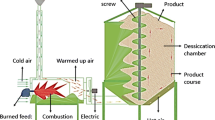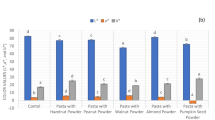Abstract
In this study, Corylus maxima Miller (foşa) hazelnut from the Trabzon area (Black Sea Coast-Turkey) was used. The moisture, oil, protein, total carbohydrate, and ash contents of the hazelnuts were determined using respective AOAC methods. The fatty acid constituents of hazelnut oil were analyzed using Gas Chromatography. Physicochemical properties of the oil were also determined. The amino acids of the samples were analyzed using a liquid-chromatographic “Amino Acid Analyzer.” Sugars were separated and detected using Thin Layer Chromatography. The hazelnut samples were roasted at 135 °C for 10, 15, 20, 25 and 30 minutes in order to determine the effect of roasting temperature. Moisture, oil, protein, total carbohydrate, total sugar and starch were also determined as a function of roasting time. Although there were not significant changes in the amount of oil, protein and starch contents (p > 0.05), the moisture and total sugar contents decreased significantly (p < 0.05) during the roasting process. The fatty acids composition, the physicochemical properties of the hazelnut oil, and the total amino acids were determined also during to the roasting process. It was found that the linoleic acid, as well as the essential amino acids and total sugar contents decreased significantly (p < 0.05) after 20 minutes of being roasted at 135 °C. It was concluded that roasting for 15 minutes at 135 °C was ideal for maintaining the desired nutritional value of hazelnuts.
Similar content being viewed by others
References
FAO Yearbook of Production; FAO Statistics Series; FAO: Rome, 1992; Vol. 46, 112. p. 184.
Zürcher K, Hadorn H (1975) Qualitats beurteilung von haselnusskernen. Mitt Gebiete Lebensm. Hyg 66: 191–224.
Zürcher K, Hadorn H (1976) Neuere methoden zur untersuchung von mandeln, aprikosenkern, haselnüssen und erdnüssen. Mitt Gebiete Lebensm Hyg 67: 170–191.
Piskornik Z, Korfel J (1983) Quantitative and qualitative analysis of the fatty acid content of 10 Hazelnut cultivars grown in Poland. Convegno Internationale sue Noccioulo, Avellino, 22-24 Sept. 351–356.
Yazicioğlu T, Karaali A (1983) On the fatty acid composition of Turkish vegetable oils. Fette, Seifen, Anstrichmittel 85: 23–30.
Garcia JM, Ağar İT, Streif J (1994) Lipid characteristics of kernels from different hazelnut vari-eties. Tr J Agric and Forest 18: 199–202.
Persian AS, Brine WM, Lull EC (1995) Analysis of factors influencing lipid oxidation in hazelnuts (Corrals spa.). J Food Porch and Preserve 19: 9–26.
Adorn H, Kamei T, Kleinert J, Messerli M, Zürcher K (1978) Lagerungsversuche und qualitat-sprüfungen haselnüssen. Gordian 10: 300–310.
Garcia OR, Valls PC, Diaz MA (1979) Contribucion al estudio de los aceites de frutos secos espanoles. caratteristicas del aceite de avellanas de las distintas variedades de la provincia de Tarragona (Campana 1976). Anal Bromatol 31: 137–158.
Baş F, Ömeroğlu S, Türdü S, Aktaş S (1986) Önemli Türk findik çeşitlerinin bileşim ve Özelliklerinin saptanmasi.Gida 11: 195–203.
Parcerisa J, Boatella J, Codony R, Farran A, Garcia J, Lopez A, Rafecas M, Romero A (1993) Influence of variety and geographical orgihon the lipid fraction of hazelnuts from Spain; I. fatty acid composition. Food Chem 48: 411–414.
Parcerisa J, Boatella J, Castellote AI, Codony R, Farran A, Garcia J, Lopez A, Rafecas M, Romero A (1994) Influence of variety and geographical origin on the lipid fraction of hazelnuts (Corylus avellana L.) from Spain: (II). trigliseride composition. Food Chem 50: 245–249.
Parcerisa J, Boatella J, Codony R, Rafecas M, Castellote AI, Garcia J, Lopez A, Romero A (1995) Comparison of fatty acid and triacylycerol compositions of different hazelnut varieties (Corylus avellana L.) cultivate Catalonia (Spain). J Agric Food Chem 43: 13–16.
Barthel G, Laskawy G, Grosch W (1974) Untersuchungen über den oxydativen fettverderb von hazelnusskernen. Deut Lebesm Rundschau 70: 201–204.
Bonvehi SJ, Coll FV (1993) Oil content stability and fatty acid composition of the main varieties of Catalonian hazelnuts (Corylus avellana L). Food Chem 48: 237–241.
Bonvehi JS, Coll FV (1993) Study of the carbohydrate fraction of the principal varieties of Tarragona hazelnuts (Corylus avellana L.). Food Chem 46: 285–288.
Radtke R, Heiss R (1971) Ueber das lagerungsverhalten von haselnüssen Türkischer provenienz. Süsswaren 15: 103–106.
Hadorn H, Zürcher K (1974) Zur bestimmung der oxydationstabilitat von Ölen und fetten. Dtsch Lebensm Rundschau 70: 57–65.
Roversi A (1973). Rilievi sull'accrescimiento e sull'accumulo in grasso dei frutti di Corylus avellana L. Ann Fac Agraria UCSC 13: 318–39.
Belitz HD, Grosch W (1987) Food Chemistry, Translation from the second German edition by D Hadziyev, Springer-Verlag-Berlin-Heidelberg.
Alphan ME, Yilmaz T, Pala M, Açkurt F (1996) Tekli doymamiş yağ asidi içeriği findikla zenginleştirilmiş diyetin karbohidrat ve lipid metabolizmasina etkisi. Gida Tekn, 7: 58–63.
ANON (1990) Official Methods of Analysis, 15 th ed. Association of Official Analytical Chemists, Kenneth Herrich (ed.) Arlington, Viginia.
ANON (1979) IUPAC Standard Methods for Analysis of Oils, Fats and Derivatives, 6 th Ed. Pergamon Press, C-Paquot, Centre National de Recherhe Scientifigue, France.
Hill DW, Walter IH, Wilson, TD, Stuard, JD (1979) High performance liquid cromatography determination in amino acids in picomole range. Anal Chem 51: 1338–1341.
Walton HF (1976) Ion-Exchange Chromatograpy, Stroudsburg, Pennsylvania, Dowden, Hutchinson & Ross Inc.
Charles WJ (1968) Separation of sugars by Thin-Layer Chromatography. J Chromatogr 34: 116–120.
Kozcaz M, Keskin H (1986) Investigation of roasted chick-pea's food value. Chim Acta Turc 14: 251–264.
Watt BK, Merrill AL (1975) Composition of Foods, Washington DC: Agriculture Handbook.
Stevenson SG, Vaisey-Genser M, Eskin NAM (1984) Quality control in the use of deep-frying oils. J Am Oil Chem Soc 61: 102–108.
O'Keefe SF, Wiley VA, Knauft DA (1993) Comparison of oxidative stability of high and normal oleic peanut oils. J Am Oil Chem Soc 70: 489–492.
Author information
Authors and Affiliations
Rights and permissions
About this article
Cite this article
Kirbaşlar, F.G., Erkmen, G. Investigation of the effect of roasting temperature on the nutritive value of hazelnuts. Plant Foods Hum Nutr 58, 1–10 (2003). https://doi.org/10.1023/B:QUAL.0000041147.61816.5c
Issue Date:
DOI: https://doi.org/10.1023/B:QUAL.0000041147.61816.5c




